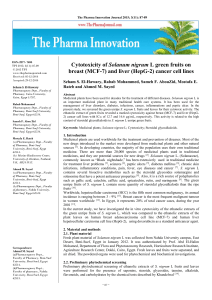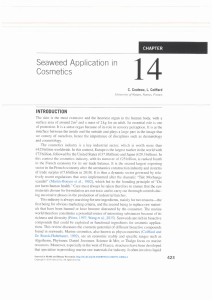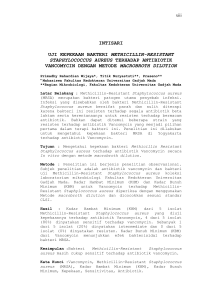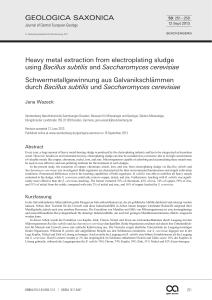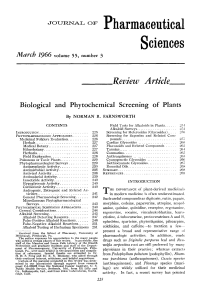Uploaded by
common.user60083
Phytochemical and Antimicrobial Studies on Garcinia lattissima Fruit Extract
advertisement
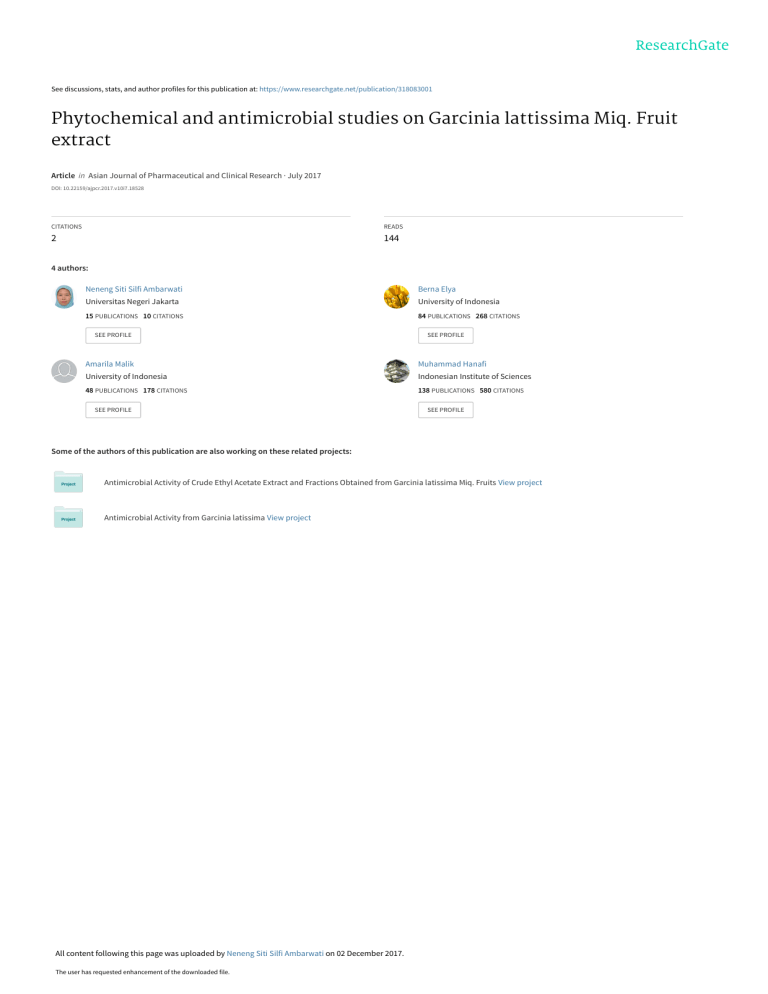
See discussions, stats, and author profiles for this publication at: https://www.researchgate.net/publication/318083001 Phytochemical and antimicrobial studies on Garcinia lattissima Miq. Fruit extract Article in Asian Journal of Pharmaceutical and Clinical Research · July 2017 DOI: 10.22159/ajpcr.2017.v10i7.18528 CITATIONS READS 2 144 4 authors: Neneng Siti Silfi Ambarwati Berna Elya Universitas Negeri Jakarta University of Indonesia 15 PUBLICATIONS 10 CITATIONS 84 PUBLICATIONS 268 CITATIONS SEE PROFILE SEE PROFILE Amarila Malik Muhammad Hanafi University of Indonesia Indonesian Institute of Sciences 48 PUBLICATIONS 178 CITATIONS 138 PUBLICATIONS 580 CITATIONS SEE PROFILE SEE PROFILE Some of the authors of this publication are also working on these related projects: Antimicrobial Activity of Crude Ethyl Acetate Extract and Fractions Obtained from Garcinia latissima Miq. Fruits View project Antimicrobial Activity from Garcinia latissima View project All content following this page was uploaded by Neneng Siti Silfi Ambarwati on 02 December 2017. The user has requested enhancement of the downloaded file. Online - 2455-3891 Print - 0974-2441 Vol 10, Issue 7, 2017 Research Article PHYTOCHEMICAL AND ANTIMICROBIAL STUDIES ON GARCINIA LATTISSIMA MIQ. FRUIT EXTRACT NENENG SITI SILFI AMBARWATI1,2, BERNA ELYA1*, AMARILA MALIK1, MUHAMMAD HANAFI3 1 Faculty of Pharmacy, Universitas Indonesia, Depok 16424, Indonesia. 2Faculty of Engineering, Jakarta State University, Jl. RawamangunMuka, East Jakarta 13220, Indonesia. 3Centre for Chemistry, Indonesian Institute of Sciences, Serpong, Banten, Indonesia. Email: [email protected] Received: 17 March 2017, Revised and Accepted: 13 April 2017 ABSTRACT Objective: The present investigation was aimed to explore the phytoconstituents present in the fruit part of Garcinia lattissima Miq. and their antimicrobial efficacy. Methods: The preliminary phytochemical constituents were qualitatively analyzed using the standard procedures described in Materia Medica Indonesia. Antimicrobial screening was performed using disc diffusion and dilution methods. Results: Phytochemical screening of different extracts of G. lattissima Miq. fruits revealed the presence of tannins, saponins, flavonoids, and alkaloids, and the results are shown in Table 1. The ethyl acetate and methanolic extracts of G. lattissima Miq. fruits showed antimicrobial activity, and the n-hexane extract failed to prove the inhibition against the selected pathogens. Conclusion: The results of the phytochemical and bio-efficacy study revealed most valuable information and also support the continued sustainable use of G. lattissima Miq. fruits in the traditional system of medicine. Keywords: Garcinia lattissima Miq., Antimicrobial, Phytochemical, Tannins, Saponins, Flavonoids, Alkaloids. © 2017 The Authors. Published by Innovare Academic Sciences Pvt Ltd. This is an open access article under the CC BY license (http://creativecommons. org/licenses/by/4. 0/) DOI: http://dx.doi.org/10.22159/ajpcr.2017.v10i7.18528 INTRODUCTION This study proposed the existence of active phytochemical compounds and to explore the antimicrobial activity in different solvents of Garcinia lattissima Miq. fruit extract. Plants as living chemical factories provide a vast number of important chemical substances that display a variety of biological actions. About 35,000 (some estimate up to 70,000) plant species are used worldwide for medicinal purposes. Researchers have investigated <0.5% of these for their phytochemical and pharmacological potentials. More latterly there has been a recovery of attracting in the medicinal possibles of therapeutic trees as antimicrobials.Also, others species have been researchedtonew antimicrobials potential of plant species [1]. The Clusiaceae or Guttiferae family contains 27 genera and 1,090 species, mostly restricted to lowland tropics [2]. Of which, Garcinia genus includes about 400 species of evergreen trees or shrubs, occurring from West Africa across tropical Asia to the Fiji Island [3], and most of these contain xanthones [2]. and moderate activity (inhibition zone was 4-7 mm) against Escherichia coli [8]. With this knowledge, the present investigation deals with the phytochemical analysis and antimicrobial efficacy of G. lattissima Miq. MATERIALS AND METHODS Plant collection and extraction G. lattissima Miq. fruits were collected and identified from the Center for Plant Conservation Bogor Botanical Gardens, Indonesian Institute of Sciences (LIPI), West Java, Indonesia. The sliced fruits were shadedried at room temperature and powdered coarsely using a mechanical homogenizer. Powdered plant material was extracted by multilevel maceration using various solvents such as n-hexane, ethyl acetate, and methanolic in a row. The filtrate of the extracts was evaporated to dryness under reduced pressure using a rotary evaporator. The extraction yields were collected, weighted, and stored at 4°C before use [1]. The extraction yield can be calculated by = extraction yield (%) Garcinia latissima Miq. commonly known as Dolomagota (Maluku, Indonesia) and the gland of the plant used as cure wound [4]. G. lattissima Miq. is distributed in East Sepik, Eastern Highlands, West Sepik, Southern Highlands, Western Highlands, Madang, Western Morobe, Milne Bay, Central Gulf, Britain, and Papua Islands [5]. In Indonesia, G. lattissima Miq. grows in Seram Island, Maluku, and in Papua, but it has been cultivated in the Bogor Botanic Gardens [6]. Constituents of the stem bark ethanol extract of G. lattissima Miq. gathered in Papua New Guinea Central Province were latisxanthone-A, latisxanthone-B, latisxanthone-C, and latisxanthone-D [7]. Latisxanthone is classified as pyranoxanthone. The G. lattissima Miq. stem bark ethanol extract collected in Papua New Guinea (Central Province) showed good antibacterial activity (inhibition zone was 8-12 mm) against Staphylococcus aureus and Bacillus subtilis (Gram-positive bacteria) dry weight of extract × 100 [9] dry weight of plant powder Phytochemical and antimicrobial activities The qualitatively analyzed phytochemical constituents used in the standard procedures were described by Fransworth and methods from Materia Medica Indonesia Volume VI [10-11]. Antimicrobial screening was performed by disc diffusion method [12]. Two Gram-positive bacteria (B. subtilis ATCC 6633 and S. aureus ATCC 25923), two Gram-negative bacteria (Pseudomonas aeruginosa ATCC 27853 and E. coli ATCC 25922), and two fungi (Candida albicans and Trichophyton mentagrophytes). The zone of inhibition against the selected pathogens was determined and recorded. The standard antibiotics used as positive control were gentamycin for S. aureus, erythromycin for B. subtilis, ciprofloxacin for P. aeruginosa, and amoxicillin for E. coli. The first step of the zone of Ambarwati et al. Asian J Pharm Clin Res, Vol 10, Issue 7, 2017, 230-232 Table 1. Phytochemical screening of G. lattissima Miq. fruits Tests Reagents used n‑hexane extracts Ethyl acetate extracts Methanolic extracts Tannins Acidic FeCl3 Gelatin Frothing test HCl+Mg turnings Borntrager’s H2SO4 Dragendorff’s Mayer’s Bouchardat’s ‑ ‑ + ‑ ‑ ‑ ‑ ‑ ‑ ‑ ‑ ‑ + ‑ ‑ + ‑ + + + ‑ + ‑ ‑ ‑ ‑ ‑ Saponins Flavonoids Anthraquinones Terpenoids Alkaloids Phytochemical screening +: Intensity reaction, ‑: Non‑detected, G. lattissima: Garcinia lattissima inhibition used crude extracts (100%) [13]. The positive results from that did the area of inhibition with 2% extracts in DMSO. These methods were in triplicate. The assay of minimum inhibitory concentration (MIC) and minimum bactericidal concentration (MBC) performed for extracts gave a zone of inhibition of 2% extracts. To determine the MIC test used the broth dilution method, and to determine the minimum bactericidal assay by plating out onto each appropriate agar plate [14]. RESULTS AND DISCUSSION Fruits from G. lattissima Miq. for this research are shown in Fig. 1. The results of extraction yields from G. lattissima Miq. fruits are shown in Table 2. The screening of phytochemical for different extracts of G. lattissima Miq. fruits revealed the existence of different chemical compounds of tannins, saponins, flavonoids, and alkaloids, and Table 1 represents the results. Flavonoids and alkaloids (using Dragendorff’s and Bouchardat’s reagents) were present in ethyl acetate extracts of G. lattissima Miq. The methanolic extracts of G. lattissima Miq. demonstrated the presence of tannins and flavonoids. The n-hexane excerpts from G. lattissima Miq. illustrated the presence of saponins only. The antimicrobial efficacy from n-hexane, methanolic, and ethyl acetate extracts (100%) of G. lattissima Miq. from this research are shown in Table 3. The inhibition zone diameters ≥ 10 mm were shown by the G. lattissima Miq. fruits’ ethyl acetate extracts opposed to P. aeruginosa and B. subtilis and the methanolic extracts of G. lattissima Miq. fruits opposed to S. aureus, P. aeruginosa, and B. subtilis. The n-hexane extracts of G. lattissima Miq. fruits against B. subtilis and the ethyl acetate extracts of G. lattissima Miq. fruits opposed to E. coli and S. aureus showed inhibition area diameter <10 mm. Methanolic extracts of G. lattissima Miq. fruits against E. coli., C. albicans, and T. mentagrophytes were resistant to all the extracts. Table 2: The average of extraction yields from the result of multilevel maceration extraction from G. lattissima Miq. fruits Solvents Yield (%) Average (%) n‑hexane 9.010 9.262 8.456 2.414 2.284 3.594 18.520 14.682 16.490 8.9093±0.4123 Ethyl acetate Methanol 2.7640±0.7217 16.5640±1.9201 G. lattissima: Garcinia lattissima Table 3: Antibacterial ability of G. lattissima Miq. fruits’ extracts (100%) Organisms B. subtilis S. aureus P. aeruginosa E. coli C. albicans T. mentagrophytes Zone of inhibition (mm) Methanolic Ethyl acetate n‑hexane ++ ++ ++ + ‑ ‑ ++ + ++ + ‑ ‑ + ‑ ‑ ‑ ‑ ‑ ++: Inhibition zone diameter≥10 mm, +: Inhibition zone diameter<10 mm, ‑: No inhibition zone, G. lattissima: Garcinia lattissima, B. subtilis: Bacillus subtilis, S. aureus: Staphylococcus aureus, P. aeruginosa: Pseudomonas aeruginosa, E. coli: Escherichia coli, C. albicans: Candida albicans, T. mentagrophytes: Trichophyton mentagrophytes Table 4 shows the results of the antibacterial activities of 2% G. lattissima Miq. fruits’ extracts in DMSO. The antibacterial activity has been observed only in the G. lattissima Miq. fruits’ ethyl acetate and methanolic extracts against the selected bacterial assay. The n-hexane extracts were unsuccessful to give the inhibition against the bacterial assay. This research used the positive control with commercially available standard antibiotic disc (erythromycin for B. subtilis, gentamycin for S. aureus, and ciprofloxacin for P. aeruginosa). The conventional medicine showed positive results against all the tested bacteria. The ethyl acetate extracts (2%) of G. lattissima Miq. fruits showed the maximum zone of inhibition against P. aeruginosa (9.82±0.978 mm) and then B. subtilis (9.62±0.431 mm). The methanolic extracts (2%) of G. lattissima Miq. fruits showed the highest zone of inhibition against S. aureus (9.97±0.448 mm) and then B. subtilis (9.53±0.416 mm) and P. aeruginosa (8.22±0.506 mm). Table 5 shows the results of dilution assay of extracts’ antimicrobial activities. The results show that MIC and MBC of the methanolic Fig. 1. Fruits of Garcinia latissima Miq. 231 Ambarwati et al. Table 4: Antibacterial activities from 2% G. latissima Miq. fruits’ extracts in DMSO using agar diffusion method Bacteria B. subtilis S. aureus P. aeuginosa The mean±SD of diameter of inhibition zone (mm) n‑hexane Ethyl acetate Methanolic Antibiotic standard 0 0 0 9.62±0.431 0 9.82±0.978 9.53±0.416 9.97±0.448 8.22±0.506 21.08±1.928 23.70±1.928 21.88±0.511 Table 5: MBC and MIC from the G. latissima Miq. fruits’ methanolic and ethyl acetate extracts (in ppm) Ethyl acetate Methanolic extracts consist of saponins only. The antimicrobial activity showed that the methanolic extracts of G. lattissima Miq. fruits had the best result than the others. ACKNOWLEDGMENT Antibiotic standard: Erythromycin 15 μg for B. subtilis, gentamycin 10 μg for S. aureus, ciprofloxacin 5 μg for P. aeruginosa, G. latissima: Garcinia latissima, B. subtilis: Bacillus subtilis, S. aureus: Staphylococcus aureus, P. aeruginosa: Pseudomonas aeruginosa, DMSO: Dimethyl sulfoxide Solvents Asian J Pharm Clin Res, Vol 10, Issue 7, 2017, 230-232 The authors thank Universitas Indonesia through HIBAH PITTA 2017 that supported this study. We are grateful to Plant Conservation Botanical Gardens Center, Indonesian Institute of Sciences, that provided researched fruits and confirmed authenticity of the fruits. REFERENCES 1. 2. 3. B. subtilis S. aureus P. aeruginosa 4. MIC MBC MIC MBC MIC MBC 5. 2500 1250 5000 5000 ‑ 5000 ‑ 10000 5000 2500 5000 2500 6. G. latissima: Garcinia latissima, B. subtilis: Bacillus subtilis, S. aureus: Staphylococcus aureus, P. aeruginosa: Pseudomonas aeruginosa, MBC: Minimum bactericidal concentration, MIC: Minimum inhibitory concentration extracts and the ethyl acetate extracts opposed to P. aeruginosa, B. subtilis, and S. aureus were different. Ethyl acetate extracts and methanolic extracts of G. lattissima Miq. fruits were active against B. subtilis (MIC=2,500 ppm and 1,250 ppm, respectively) and against P. aeruginosa (MIC=5,000 ppm and 2,500 ppm, respectively). The methanolic extracts of G. lattissima Miq. fruits were active against S. aureus (MIC=5,000 ppm). The ethyl acetate extracts of G. lattissima Miq. fruits were not tested for Gram-positive bacteria S. aureus because they did not give inhibition zone in 2% G. lattissima Miq. fruits’ extracts assay. The methanolic extracts have more powerful activity of antimicrobials as contrast to ethyl acetate extracts. The results of the study indicate that G. lattissima Miq. fruits’ extracts could be useful for antibacterial uses [15]. CONCLUSION This study indicated that the methanolic extracts of G. lattissima Miq. fruits had the highest rendemen than the others. The methanolic extracts consist of tannins and flavonoids, qualitatively. The ethyl acetate extracts include flavonoids and alkaloids, and the hexane 7. 8. 9. 10. 11. 12. 13. 14. 15. Johnson M, Kalaiarasi V, Sivaraman A, Janakiraman N, Babu A, Narayani M. Phytochemical and antibacterial studies on Aristolochia tagala Cham. World J Pharm Res 2014;3(2):2172-8. Stevens PF. The families and genera of fascular plants. In: Flowering Plants. Vol. 9. Berlin, Heidelberg: Springer-Verlag; 2007. p. 48-66. Ramage CM, Sando L, Peace CP, Carroll BJ, Drew RA. Genetic diversity revealed in the apomictic fruit species Garcinia mangostana L. (Mangosteen). Euphytica 2004;136(1):1-10. Eisai P. Medicinal Herb Index in Indonesia. 2nd ed. Indonesia: P.T. Eisai; 1995. p. 71. Conn B, Damas K. PNGTreesKey-Garcinia latissima Miq. In: Annales Musei Botanici Lugduno-Batavi. Vol. 1. New South Wales, Papua New Guinea: National Herbarium; 1863. Sari R, Ruspandi, Ariati SR. An Alphabetical List of Plant Species Cultivated in the Bogor Botanic Gardens. Bogor: LIPI; 2010. Ito C, Miyamoto Y, Nakayama M, Kawai Y, Rao KS, Furukawa H. A novel depsidone and some new xanthones from Garcinia species. Chem Pharm Bull 1997;45(9):1403. Rao KS. Antibacterial activity of some medicinal plants of Papua New Guinea. Int J Pharmacogn 1996;34(3):223-5. Yin NG, Abdullah S, Phin CK. Phytochemical constituents from leaves of Elaeis guineensis and their antioxidant and antimicrobial activities. Int J Pharm Pharm Sci 2013;5(4):137-40. Fransworth NR. Biological and phytochemical screening of plants. J Pharm Sci 1995;22(3):226-76. Depkes RI. Materia Medika Indonesia. Vol. VI. Jakarta: Departemen Kesehatan Republik Indonesia; 1995. Bamas SS, Kingsley SJ, Sankaranarayanan S. Antibacterial activity of different phytochemical extracts from the leaves of T. Procumbens. Linn.: Identification and Mode of action of the terpenoid compound as antibacterial. Int J Pharm Pharm Sci 2012;4:557-64. Mathew S. An evaluation of the antimicrobial activity of various concentrations of Ocimum sanctum against various species of bacteria: An in vitro study. Int J Adv Appl Sci 2014;3(1):33-6. Jeong MR, Kim HY, Cha JD. Antimicrobial activity of methanol extract from Ficus carica Leaves against oral bacteria. J Bacteriol Virol 2009;39(2):97-102. Sanches NR, Cortez DA, Schiavini MS, Nakamura CV, Dias-Filho BP. An evaluation of antibacterial activities of Psidium guajava (L.). Braz Arch Biol Technol 2005;48(3):429-36. 232 View publication stats

